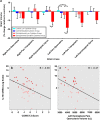Elevated peripheral cytokines characterize a subgroup of people with schizophrenia displaying poor verbal fluency and reduced Broca's area volume
- PMID: 26194183
- PMCID: PMC4960447
- DOI: 10.1038/mp.2015.90
Elevated peripheral cytokines characterize a subgroup of people with schizophrenia displaying poor verbal fluency and reduced Broca's area volume
Abstract
Previous studies on schizophrenia have detected elevated cytokines in both brain and blood, suggesting neuroinflammation may contribute to the pathophysiology in some cases. We aimed to determine the extent to which elevated peripheral cytokine messenger RNA (mRNA) expression: (1) characterizes a subgroup of people with schizophrenia and (2) shows a relationship to cognition, brain volume and/or symptoms. Forty-three outpatients with schizophrenia or schizoaffective disorder and matched healthy controls were assessed for peripheral cytokine mRNAs (interleukin (IL)-1β, IL-2, IL-6, IL-8 and IL-18), intelligence quotient, memory and verbal fluency, symptom severity and cortical brain volumes integral to language (that is, Broca's and Wernicke's areas). IL-1β mRNA levels were 28% increased in schizophrenia compared with controls (t(82)=2.64, P<0.01). Using a two-step clustering procedure, we identified a subgroup of people displaying relatively elevated cytokine mRNA levels (17/43 people with schizophrenia and 9/42 controls). Individuals with schizophrenia in the elevated cytokine subgroup performed significantly worse than the low-cytokine subgroup on verbal fluency (F(1,40)=15.7, P<0.001). There was a 17% volume reduction of the left pars opercularis (POp) (Broca's area) in patients with elevated cytokines compared with patients with lower cytokines (F(1,29)=9.41, P=0.005). Negative linear relationships between IL-1β mRNA levels and both verbal fluency and left POp volume were found in schizophrenia. This study is among the first to link blood biomarkers of inflammation with both cognitive deficits and brain volume reductions in people with schizophrenia, supporting that those with elevated cytokines represent a neurobiologically meaningful subgroup. These findings raise the possibility that targeted anti-inflammatory treatments may ameliorate cognitive and brain morphological abnormalities in some people with schizophrenia.
Figures




References
-
- Tsuang MT, Lyons MJ, Faraone SV. Heterogeneity of schizophrenia. Conceptual models and analytic strategies. Br J Psychiatry 1990; 156: 17–26. - PubMed
-
- Nawa H, Takei N. Recent progress in animal modeling of immune inflammatory processes in schizophrenia: implication of specific cytokines. Neurosci Res 2006; 56: 2–13. - PubMed
-
- Fillman SG, Cloonan N, Catts VS, Miller LC, Wong J, McCrossin T et al. Increased inflammatory markers identified in the dorsolateral prefrontal cortex of individuals with schizophrenia. Mol Psychiatry 2013; 18: 206–214. - PubMed
Publication types
MeSH terms
Substances
LinkOut - more resources
Full Text Sources
Other Literature Sources
Medical
Miscellaneous

